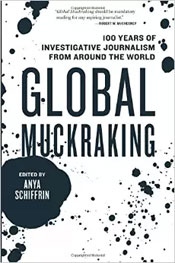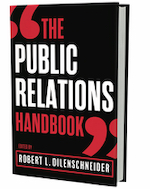The last century has seen widespread economic changes in labor, production and the distribution of goods, as well as increased governmental oversight. These sweeping changes have captured the attention of a curious and proactive news media, which appointed itself the guardian of the public to expose misdeeds in both industry and government. In Global Muckraking: 100 Years of Investigative Journalism from Around the World, [The New Press, 2014], Anya Schiffrin has compiled examples of effective and eye-opening reporting on a variety of topics on nearly every continent.
In Global Muckraking: 100 Years of Investigative Journalism from Around the World, [The New Press, 2014], Anya Schiffrin has compiled examples of effective and eye-opening reporting on a variety of topics on nearly every continent.
Schiffrin, who is the Director of the media and communications program at the Columbia School of International Public Affairs, organized reporting under a number of topics such as labor abuses, corruption, military and the environment. Each selection is prefaced with an essay by a prominent expert.
As media outlets around the world scale back resources on investigative journalism, Global Muckraking is a fine primer on what journalism is supposed to be.
For more than thirty years, China has had a one-child policy. Chinese journalist Pang Jiaoming delved into cases of corruption and child trafficking and, during the investigation, uncovered an example of a rural family who had their baby daughter seized. The family was supposed to pay a 6,000 Yuan (U S $1,000 ) maintenance fee, since the child was not the family’s first. In fact, many of the children seized in the name of the one-child policy were sold to adoption agencies. Pang’s reporting shows that many American families who adopted Chinese babies thought they had adopted orphans, when in fact, they were sold.
Another issue discussed in Global Muckraking is sweatshop labor. Kathie Lee Gifford, the perky morning television host, was thrust into a public relations crisis when it was reported that her Wal-Mart clothing line was being sewn by women earning sixty cents per hour.
This was a sensational story in 1999. Yet, readers will be surprised to learn which outlet broke the story: The National Enquirer. Despite its salacious stories, the Enquirer’s report was thorough. It told of often poor conditions. The temperature in the factory often went over 100 degrees. Seamstress Norma Elizabeth Alvarez worked a six-day, sixty-hour work week. According to Alvarez, there was one forty-minute break and only one vacation when the factory closed at Christmas.
It is also interesting to compare some of the stories to see similarities in labor abuses that took place decades apart.
One such instance was an essay from 1886 in the Bengalee, a newspaper covering India, entitled “Slavery in the British Dominion,” which focused on indentured servants harvesting tea in Assam. The reporter describes how the most ignorant classes were lured into service with the promise of a living wage.
Another article, “The Fishing Industry’s Cruelest Catch” makes many of the same points. That article was published in September 2012. Fishermen were forced to sign vaguely worded contracts that held them in service until work was complete to the fishing boat captain’s satisfaction. Anyone who left the job would have to pay $3,500 to the employer.
Overall, Global Muckraking is a fine academic source. It should be read by aspiring journalists. While there are many articles that will leave the reader flabbergasted, it should be noted that many of these articles did not affect change. Readers expecting triumphant Woodward and Bernstein tales will be disappointed.
Kevin P. McVicker is vice president with Shirley & Banister Public Affairs in Alexandria, Va.


 Time correspondent Simon Shuster’s “The Showman” demonstrates how Ukraine president Volodymyr Zelensky’s masterful knowledge of PR tactics and the power of propaganda transformed him from comedian into a respected world leader.
Time correspondent Simon Shuster’s “The Showman” demonstrates how Ukraine president Volodymyr Zelensky’s masterful knowledge of PR tactics and the power of propaganda transformed him from comedian into a respected world leader. Iuliia Mendel, who served as press secretary for Ukraine president Volodymyr Zelensky from 2019 to 2021, will release a book called “The Fight Of Our Lives” in September, published by Simon & Schuster’s One Signal Publishers.
Iuliia Mendel, who served as press secretary for Ukraine president Volodymyr Zelensky from 2019 to 2021, will release a book called “The Fight Of Our Lives” in September, published by Simon & Schuster’s One Signal Publishers. Robert Dilenschneider, former CEO of Hill and Knowlton, is releasing the fifth edition of The Public Relations Handbook on Feb. 15.
Robert Dilenschneider, former CEO of Hill and Knowlton, is releasing the fifth edition of The Public Relations Handbook on Feb. 15.  Big Advertising may be down for the count, but the power of marketing lives on. That’s the big takeaway from Paul Dyer’s “Friction Fatigue,” a look at what advertising’s downward spiral means for “future-focused brands."
Big Advertising may be down for the count, but the power of marketing lives on. That’s the big takeaway from Paul Dyer’s “Friction Fatigue,” a look at what advertising’s downward spiral means for “future-focused brands." Sabrina Horn, the high-tech PR guru who sold her Horn Group to Finn Partners in 2015, has published “Make It, Don’t Fake It.”
Sabrina Horn, the high-tech PR guru who sold her Horn Group to Finn Partners in 2015, has published “Make It, Don’t Fake It.”


 Have a comment? Send it to
Have a comment? Send it to 
No comments have been submitted for this story yet.